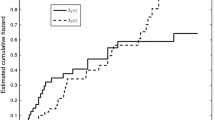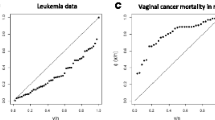Abstract
A unified test is proposed to detect trend change in hazard functions. Test statistics based on a weighted integral approach are constructed utilizing a measure of deviation from exponentiality. We exploit L-statistic theory to obtain the exact and asymptotic distributions of our statistics and establish the consistency of the test. Theoretical results of previous works are obtained as special cases. A simulation study shows significant improvement in power depending on appropriate choice of parameters j and k introduced in our work. Finally, applications to real life data sets are presented to illustrate our results.
Similar content being viewed by others
References
Aarset MV (1987) How to identify a bathtub hazard rate. IEEE Trans Reliab R–36:106–108
Alidrisi MS, Abad S, Ozkul O (1991) Regression models for estimating survival of patients with non-Hodgkin’s lymphoma. Microelectron Reliab 31:473–480
Andersen PK, Borgan O, Gill RD, Keiding N (1993) Statistical models based on counting processes. Springer, New York
Anis MZ (2013) A family of tests for exponentiality against IFR alternatives. J Stat Plan Inference 143:1409–1415
Anis MZ (2014) Tests of non-monotonic stochastic aging notions in reliability theory. Stat Papers 55:691–714
Anis MZ, Mitra M (2011) A generalized Hollander-Proschan type test for NBUE alternatives. Stat Probab Lett 81(1):126–132
Bain LJ (1974) Analysis of linear failure rate life-testing distributions. Technometrics 16:551–560
Belzunce F, Pinar JF, Ruiz JM (2005) On testing the dilation order and HNBUE alternatives. Ann Inst Stat Math 57(4):803–815
Bergman B, Klefsjö B (1989) A family of test statistics for detecting monotone mean residual life. J Stat Plan Inference 21:161–178
Berrendero JR, Cárcamo J (2009) Characterizations of exponentiality within the HNBUE class and related tests. J Stat Plan Inference 139:2399–2406
Bickel PJ, Doksum K (1969) Tests of monotone failure rate based on normalized spacings. Ann Math Stat 40:1216–1235
Boos DD (1979) A differential for L-statistics. Ann Stat 7:955–959
Box GEP (1954) Some theorems on quadratic forms applied in the study of analysis variance problems, I. Effect of inequality of variance in the one way classification. Ann Math Stat 25:290–302
Bray T, Crawford G, Proschan F (1967) Maximum likelihood estimation of a U-shaped failure rate function. Math Note vol 534. Boeing Scientific Research Laboratories, Seattle, WA
Davis DJ (1952) An analysis of some failure data. J Am Stat Assoc 47:113–150
Diab LS (2010) Testing for NBUL using goodness of fit approach with applications. Stat Papers 51:27–40
Duan Q, Liu J (2016) Modelling a bathtub-shaped failure rate by a Coxian distribution. IEEE Trans Reliab 65(2):878–885
Ebeling CE (1997) An introduction to reliability and maintainability engineering, International edn. McGraw-Hill Inc, New York
Fortiana F, Grané A (2002) A scale-free goodness-of-fit statistic for the exponential distribution based on maximum correlations. J Stat Plan Inference 108:85–97
Ghosh S, Mitra M (2017a) A Hollander-Proschan type test when ageing is not monotone. Stat Probab Lett 121:119–127
Ghosh S, Mitra M (2017b) A weighted integral approach to testing against HNBUE alternatives. Stat Probab Lett 129:58–64
Glaser RE (1980) Bathtub and related failure rate characterizations. J Am Stat Assoc 75:667–672
Guess F, Hollander M, Proschan F (1986) Testing exponentiality versus a trend change in mean residual life. Ann Stat 14(4):1388–1398
Hawkins DL, Kochar S, Loader C (1992) Testing exponentiality against IDMRL distributions with unknown change point. Ann Stat 20:280–290
Hjorth U (1980) A reliability distribution with increasing, decreasing, constant bathtub failure rates. Technometrics 22:99–107
Hollander M, Proschan F (1975) Tests for the mean residual life. Biometrika 62(3):585–593
Kamins M (1962) Rules for planned replacement of aircraft and missile parts. RAND Memo RM-2810-PR, RAND Corp, Santa Monica, CA
Klar B (2003) On a test of exponentiality against Laplace order dominance. Statistics 37(6):505–515
Lai CD, Xie M (2006) Stochastic ageing and dependence for reliability. Springer, New York
Lai CD, Xie M, Murthy DNP (2001) Bathtub-shaped failure rate life distributions. Handb Stat 20:69–104
Lim JH, Park DH (1998) A family of tests for trend change in mean residual life. Commun Stat Theory Methods 27(5):1163–1179
Majumder P, Mitra M (2017) A test for detecting Laplace order dominance and related Bahadur efficiency issues. Stat Papers https://doi.org/10.1007/s00362-017-0901-0
Matsunawa T (1985) The exact and approximate distributions of linear combinations of selected order statistics from a uniform distribution. Ann Inst Stat Math 37:1–16
Matthews DE, Farewell VT (1982) On testing for a constant hazard against a change-point alternative. Biometrics 38:463–468
Matthews DE, Farewell VT, Pyke R (1985) Asymptotic score-statistic processes and tests for constant hazard against a change-point alternative. Ann Stat 13:583–591
Mitra M, Anis MZ (2008) An \(L\)-statistic approach to a test of exponentiality against IFR alternatives. J Stat Plan Inference 138:3144–3148
Mudholkar GS, Srivastava DK (1993) Exponentiated Weibull family for analyzing bathtub failure-rate data. IEEE Trans Reliab 42:299–302
Na MH, Lee S (2003) A family of IDMRL tests with unknown turning point. Statistics 37(5):457–462
Na MH, Jeon J, Park DH (2005) Testing whether failure rate changes its trend with unknown change point. J Stat Plan Inference 129:317–325
Pamme H, Kunitz H (1993) Detection and modelling of aging properties in lifetime data. In: Basu AP (ed) Advances in reliability. North-Holland, New York, pp 291–302
Park DH (1988) Testing whether failure rate changes its trend. IEEE Trans Reliab 37(4):375–378
Proschan F (1963) Theoretical explanation of observed decreasing failure rate. Technometrics 5(3):375–383
Rajarshi MB, Rajarshi SM (1988) Bathtub distributions—a review. Commun Stat Theory Methods 17:2597–2622
Sankaran PG, Midhu NN (2016) Testing exponentiality using mean residual quantile function. Stat Papers 57:235–247
Serfling RJ (1980) Approximation theorems of mathematical statistics. Wiley, New York
Shen Y, Tang L-C, Xie M (2009) A model for upside-down bathtub-shaped mean residual life and its properties. IEEE Trans Reliab 58(3):425–431
Wu JW, Wu CC, Tsai MH (2005) Optimal parameter estimation of the two-parameter bathtub-shaped lifetime distribution based on a type II right censored sample. Appl Math Comput 167(2):807–819
Xie M, Lai CD (1995) Reliability analysis using additive Weibull model with bathtub-shaped failure rate function. Reliab Eng Syst Saf 52:87–93
Xie M, Tang Y, Goh TN (2002) A modified Weibull extension with bathtub-shaped failure rate function. Reliab Eng Syst Saf 76:279–285
Zhang T, Dwight R, El-Akruti K (2013) On a Weibull related distribution model with decreasing, increasing and upside-down bathtub-shaped failure rate. In IEEE 2013 annual reliability and maintainability symposium (RAMS)—Orlando, FL (2013.1.28–2013.1.31)
Acknowledgements
The authors are grateful to all anonymous reviewers for their insightful comments on an earlier version of this manuscript which have led to a substantial improvement in the presentation of the paper.
Author information
Authors and Affiliations
Corresponding author
Additional information
Publisher's Note
Springer Nature remains neutral with regard to jurisdictional claims in published maps and institutional affiliations.
Appendix
Appendix
Proof of Proposition 1:
Substituting the limits of integration in (1) we have,
A lengthy and involved computation using integration by parts and interchange of the order of integration yields
and
Therefore, using equation (8) and the results of the following integrations for any \(l>0\), \(\int _0^{F^{-1}(p)}(\bar{F}(s))^l ds = (1-p)^l F^{-1}(p)+ l \int _0^{F^{-1}(p)}s(\bar{F}(s))^{l-1} dF(s)\) and \(\int _{F^{-1}(p)}^\infty (\bar{F}(s))^l ds = -(1-p)^l F^{-1}(p)+ l \int _{F^{-1}(p)}^\infty s(\bar{F}(s))^{l-1} dF(s),\) we obtained the final result. \(\square \)
Proof of Proposition 2:
Using a plug-in estimator in (1) (viz. empirical distribution function \(\hat{F}_n\) for the unknown life distribution function F), we have
which on simplification yields the result. \(\square \)
In Theorem 4 the expression for variance of \(T_{j,k}^*(\hat{F}_n)\) under \(H_0\) is given as follows: for \(j \ne \frac{1}{2}\), \(k > \frac{1}{2}\),
and for \(j = \frac{1}{2}\), \(k > \frac{1}{2}\),
Rights and permissions
About this article
Cite this article
Majumder, P., Mitra, M. Detecting trend change in hazard functions—an L-statistic approach. Stat Papers 62, 31–52 (2021). https://doi.org/10.1007/s00362-018-01074-8
Received:
Revised:
Published:
Issue Date:
DOI: https://doi.org/10.1007/s00362-018-01074-8
Keywords
- Life distribution
- Hazard function
- Change point
- L-statistic
- Asymptotic normality
- Modified Weibull extension




